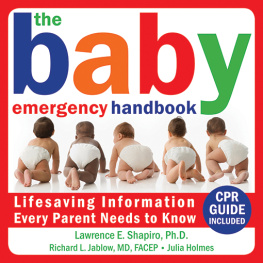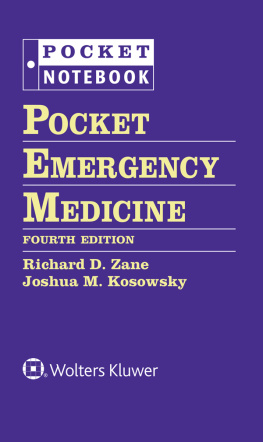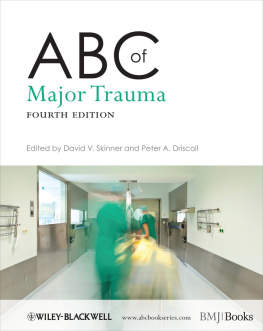First Aid at Sea This book provides rapidly accessible guidelines for dealing with medical emergencies in a small boat or yacht at sea. It is not a comprehensive textbook on first aid and it is strongly recommended that all seafarers should receive general training in first aid. Responsibility for first aid should be given to a nominated and appropriately trained member of any crew. The environment of the vessel and the sea imposes major limitations upon what can be achieved in the care of illness or injury while afloat. First aid treatment that may be appropriate ashore has to be modified at sea. The aims of
First Aid at Sea are to: preserve life prevent further harm relieve pain and suffering and deliver a live patient ashore.
Safety and simplicity should guide the management of every case so that any unnecessary treatment or intervention is avoided. Conditions that threaten life or limb demand heroic action and conditions that threaten permanent damage or disability require urgent attention. Many other conditions will be infinitely better treated ashore even after a significant delay, and all that is required at sea is basic damage limitation and pain relief. Seek help early in all cases of serious illness or injury, and for other cases if any doubt exists about correct management. Before using the radio, write down details of the case as listed . Keep this book in a readily accessible place so that it is instantly available.
While every attempt has been made to present safe and effective first aid guidelines in this book, the authors and the publishers do not accept any responsibility for the outcome of any first aid or treatment that is administered to any person in any circumstance whatsoever. The recommendations for Basic Life Support (BLS) are based on the 2015 Resuscitation Guidelines, published by the Resuscitation Council (UK): www.resus.org.uk The use of the Automatic External Defibrillator (AED) is not included in the section on resuscitation which covers only Basic Life Support. The use of an AED on a small vessel at sea is potentially dangerous. The situation is quite different if the casualty is ashore and an AED is readily available. ADLARD COLES Bloomsbury Publishing Plc 50 Bedford Square, London, WC1B 3DP This electronic edition published in 2018 by Bloomsbury Publishing Plc BLOOMSBURY, ADLARD COLES and the Adlard Coles logo are trademarks of Bloomsbury Publishing Plc First published in Great Britain 1991 by International Log Books A/S, a division of Sandvicks Bokforlag This seventh edition published 2018 Copyright Dr Colin Berry and Dr Douglas Justins, 2018 Dr Colin Berry and Dr Douglas Justins have asserted their right under the Copyright, Designs and Patents Act, 1988, to be identified as Authors of this work All rights reserved
You may not copy, distribute, transmit, reproduce or otherwise make available this publication (or any part of it) in any form, or by any means (including without limitation electronic, digital, optical, mechanical, photocopying, printing, recording or otherwise), without the prior written permission of the publisher. Any person who does any unauthorised act in relation to this publication may be liable to criminal prosecution and civil claims for damages.
A catalogue record for this book is available from the British Library Library of Congress Cataloguing-in-Publication data has been applied for ISBN: 978-1-4729-5341-4 (PB)
ISBN: 978-1-4729-5340-7 (eBook)
ISBN: 978-1-4729-5339-1 (ePDF) Illustrations: davidhurtado.com To find out more about our authors and their books please visit www.bloomsbury.com where you will find extracts, author interviews and details of forthcoming events, and to be the first to hear about latest releases and special offers, sign up for our newsletter. First Aid Protocol i During any major incident involving injury or illness, the safety of the crew and vessel must remain paramount. The following sequence may help you to prioritise what to do while still providing first aid to the casualty. Continually reassess the ongoing safety. It may help to make brief notes if communication with external agencies is likely. AVPU Is the person ALERT? Is the person responding to VERBAL enquiry? Is the person responding to PAIN? Is the person completely UNRESPONSIVE? Consider mechanism of injury or illness. CONTROL CATASTROPHIC BLEEDING with direct or indirect pressure (see ). CONTROL CATASTROPHIC BLEEDING with direct or indirect pressure (see ).
If RESPONSIVE Provide appropriate first aid. If UNRESPONSIVE Turn victim on to back, check ABC (see ). A AIRWAY B BREATHING C CIRCULATION  REASSESSMENT SECONDARY SURVEY Full examination (see ) Full history past illness, medication, allergies Progress of current condition SEEK HELP (see )
REASSESSMENT SECONDARY SURVEY Full examination (see ) Full history past illness, medication, allergies Progress of current condition SEEK HELP (see )  DECISIONEmergency to save life or limb (see ) Evacuation Urgent Sail to nearest port immediately Expedite Sail to convenient port Condition under control Sail on Contents Bleeding & Shock i Blood transports oxygen around the body. Without oxygen the vital organs such as the brain, heart, liver and kidneys cease to function. Loss of 25% of the bodys blood can lead to death. CATASTROPHIC BLEEDING
DECISIONEmergency to save life or limb (see ) Evacuation Urgent Sail to nearest port immediately Expedite Sail to convenient port Condition under control Sail on Contents Bleeding & Shock i Blood transports oxygen around the body. Without oxygen the vital organs such as the brain, heart, liver and kidneys cease to function. Loss of 25% of the bodys blood can lead to death. CATASTROPHIC BLEEDING Treatment Control life-threatening bleeding immediately with direct or indirect pressure. CATASTROPHIC BLEEDING
Treatment Control life-threatening bleeding immediately with direct or indirect pressure. CATASTROPHIC BLEEDING Treatment Control life-threatening bleeding immediately with direct or indirect pressure.
Treatment Control life-threatening bleeding immediately with direct or indirect pressure.
Apply a tourniquet for uncontrollable bleeding from a limb. Tightly applied bandage or strips of T-shirt or equivalent wrapped around the limb above the injury tight enough to be very uncomfortable AND stop the bleeding. 
 Ideally protective gloves should always be worn when dealing with blood or any body fluids.EXTERNAL BLEEDING
Ideally protective gloves should always be worn when dealing with blood or any body fluids.EXTERNAL BLEEDING Bleeding can occur from any wound. In most cuts or wounds the blood oozes from the smallest blood vessels (capillaries) only, but in deeper cuts the larger vessels (arteries and veins) may be cut and the bleeding is more dramatic. Arterial bleeding produces spurts of bright red blood and is the most serious problem.
 Treatment
Treatment If possible check for foreign objects in the wound.
Wipe or rinse off any small objects from the wounds surface using antiseptic solution or clean fresh water. Apply firm continuous direct pressure over the site of bleeding for at least 10 minutes. Use hand or fingers initially; substitute dressing pad when available and bandage firmly; if bleeding continues, add further dressing pads on top of initial pad.











 REASSESSMENT SECONDARY SURVEY Full examination (see ) Full history past illness, medication, allergies Progress of current condition SEEK HELP (see )
REASSESSMENT SECONDARY SURVEY Full examination (see ) Full history past illness, medication, allergies Progress of current condition SEEK HELP (see )  DECISIONEmergency to save life or limb (see ) Evacuation Urgent Sail to nearest port immediately Expedite Sail to convenient port Condition under control Sail on Contents Bleeding & Shock i Blood transports oxygen around the body. Without oxygen the vital organs such as the brain, heart, liver and kidneys cease to function. Loss of 25% of the bodys blood can lead to death. CATASTROPHIC BLEEDING
DECISIONEmergency to save life or limb (see ) Evacuation Urgent Sail to nearest port immediately Expedite Sail to convenient port Condition under control Sail on Contents Bleeding & Shock i Blood transports oxygen around the body. Without oxygen the vital organs such as the brain, heart, liver and kidneys cease to function. Loss of 25% of the bodys blood can lead to death. CATASTROPHIC BLEEDING Treatment Control life-threatening bleeding immediately with direct or indirect pressure. CATASTROPHIC BLEEDING
Treatment Control life-threatening bleeding immediately with direct or indirect pressure. CATASTROPHIC BLEEDING
 Ideally protective gloves should always be worn when dealing with blood or any body fluids.EXTERNAL BLEEDING Bleeding can occur from any wound. In most cuts or wounds the blood oozes from the smallest blood vessels (capillaries) only, but in deeper cuts the larger vessels (arteries and veins) may be cut and the bleeding is more dramatic. Arterial bleeding produces spurts of bright red blood and is the most serious problem.
Ideally protective gloves should always be worn when dealing with blood or any body fluids.EXTERNAL BLEEDING Bleeding can occur from any wound. In most cuts or wounds the blood oozes from the smallest blood vessels (capillaries) only, but in deeper cuts the larger vessels (arteries and veins) may be cut and the bleeding is more dramatic. Arterial bleeding produces spurts of bright red blood and is the most serious problem.  Treatment If possible check for foreign objects in the wound.
Treatment If possible check for foreign objects in the wound.